DBMS Normalization
Normalization is a process of organizing the data in database to avoid data redundancy, insertion anomaly, update anomaly & deletion anomaly. Let’s discuss about anomalies first then we will discuss normal forms with examples.
Anomalies in DBMS
There are three types of anomalies that occur when the database is not normalized. These are – Insertion, update and deletion anomaly. Let’s take an example to understand this.
Example
Suppose a manufacturing company stores the employee details in a table named employee that has four attributes: emp_id for storing employee’s id, emp_name for storing employee’s name, emp_address for storing employee’s address and emp_dept for storing the department details in which the employee works. At some point of time the table looks like this:
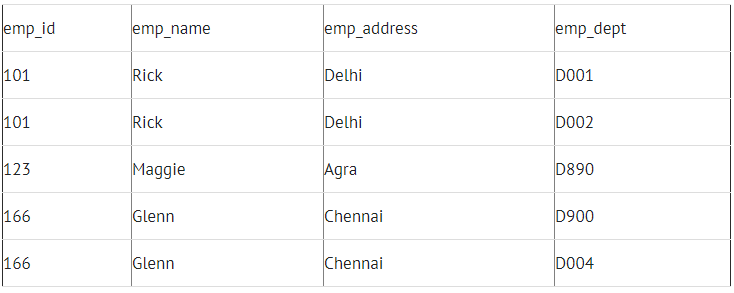
The above table is not normalized. We will see the problems that we face when a table is not normalized.
Update anomaly: In the above table we have two rows for employee Rick as he belongs to two departments of the company. If we want to update the address of Rick then we have to update the same in two rows or the data will become inconsistent. If somehow, the correct address gets updated in one department but not in other then as per the database, Rick would be having two different addresses, which is not correct and would lead to inconsistent data.
Insert anomaly: Suppose a new employee joins the company, who is under training and currently not assigned to any department then we would not be able to insert the data into the table if emp_dept field doesn’t allow nulls.
Delete anomaly: Suppose, if at a point of time the company closes the department D890 then deleting the rows that are having emp_dept as D890 would also delete the information of employee Maggie since she is assigned only to this department.
To overcome these anomalies we need to normalize the data. In the next section we will discuss about normalization.
Normalization
Here are the most commonly used normal forms:
First normal form(1NF)
Second normal form(2NF)
Third normal form(3NF)
Boyce & Codd normal form (BCNF)
First normal form (1NF)
As per the rule of first normal form, an attribute (column) of a table cannot hold multiple values. It should hold only atomic values.
Example
Suppose a company wants to store the names and contact details of its employees. It creates a table that looks like this:
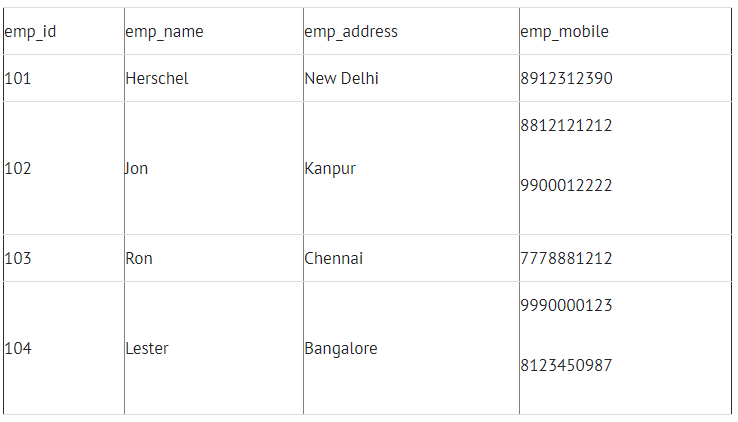
Two employees (Jon & Lester) are having two mobile numbers so the company stored them in the same field as you can see in the table above.
This table is not in 1NF as the rule says “each attribute of a table must have atomic (single) values”, the emp_mobile values for employees Jon & Lester violates that rule.
To make the table complies with 1NF we should have the data like this:
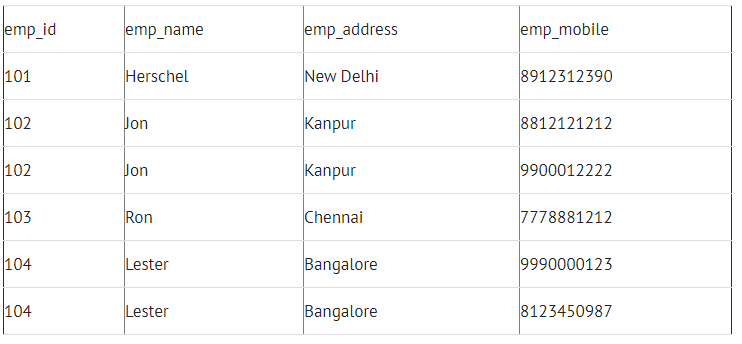
Second normal form (2NF)
A table is said to be in 2NF if both the following conditions hold:
Table is in 1NF (First normal form)
No non-prime attribute is dependent on the proper subset of any candidate key of table. An attribute that is not part of any candidate key is known as non-prime attribute.
Example
Suppose a school wants to store the data of teachers and the subjects they teach. They create a table that looks like this: Since a teacher can teach more than one subjects, the table can have multiple rows for a same teacher.

Candidate Keys: {teacher_id, subject}
Non prime attribute: teacher_age
The table is in 1 NF because each attribute has atomic values. However, it is not in 2NF because non prime attribute teacher_age is dependent on teacher_id alone which is a proper subset of candidate key. This violates the rule for 2NF as the rule says “no non-prime attribute is dependent on the proper subset of any candidate key of the table”.
To make the table complies with 2NF we can break it in two tables like this: teacher_details table:

teacher_subject table:

Now the tables comply with Second normal form (2NF).
Third Normal form (3NF)
A table design is said to be in 3NF if both the following conditions hold:
Table must be in 2NF
Transitive functional dependency of non-prime attribute on any super key should be removed. An attribute that is not part of any candidate key is known as non-prime attribute.
In other words 3NF can be explained like this: A table is in 3NF if it is in 2NF and for each functional dependency X-> Y at least one of the following conditions hold:
X is a super key of table
Y is a prime attribute of table
An attribute that is a part of one of the candidate keys is known as prime attribute.
Example
Suppose a company wants to store the complete address of each employee, they create a table named employee_details that looks like this:
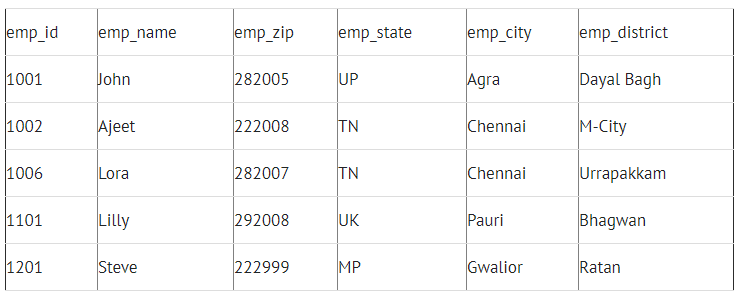
Super keys: {emp_id}, {emp_id, emp_name}, {emp_id, emp_name, emp_zip}…so on
Candidate Keys: {emp_id}
Non-prime attributes: all attributes except emp_id are non-prime as they are not part of any candidate keys.
Here, emp_state, emp_city & emp_district dependent on emp_zip. And, emp_zip is dependent on emp_id that makes non-prime attributes (emp_state, emp_city & emp_district) transitively dependent on super key (emp_id). This violates the rule of 3NF.
To make this table complies with 3NF we have to break the table into two tables to remove the transitive dependency:
employee table:
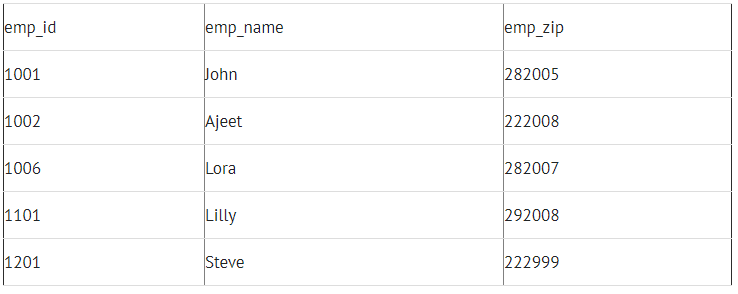
employee_zip table:
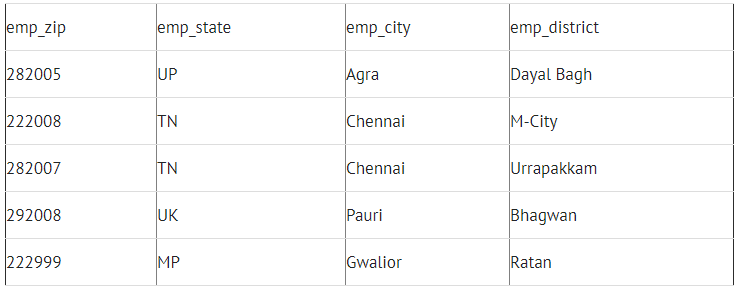
Boyce Codd normal form (BCNF)
It is an advance version of 3NF that’s why it is also referred as 3.5NF. BCNF is stricter than 3NF. A table complies with BCNF if it is in 3NF and for every functional dependency X->Y, X should be the super key of the table.
Example
Suppose there is a company wherein employees work in more than one department. They store the data like this:

Functional dependencies in the table above:
emp_id -> emp_nationality
emp_dept -> {dept_type, dept_no_of_emp}
Candidate key: {emp_id, emp_dept}
The table is not in BCNF as neither emp_id nor emp_dept alone are keys.
To make the table comply with BCNF we can break the table in three tables like this:
emp_nationality table:

emp_nationality table:

emp_nationality table:

Functional dependencies:
emp_id -> emp_nationality
emp_dept -> {dept_type, dept_no_of_emp}
Candidate keys:
For first table: emp_id
For second table: emp_dept
For third table: {emp_id, emp_dept}
This is now in BCNF as in both the functional dependencies left side part is a key.

Leave Comment